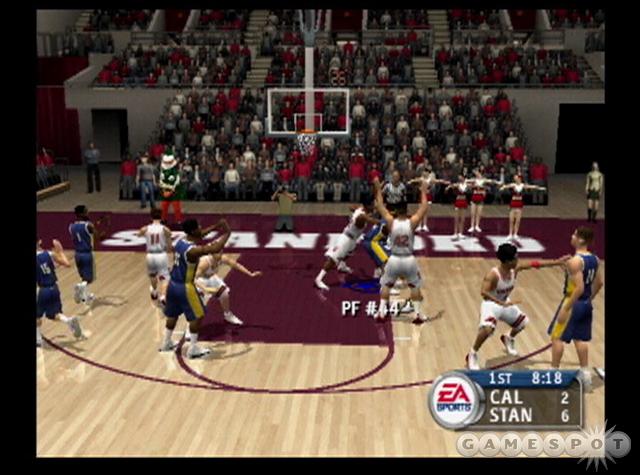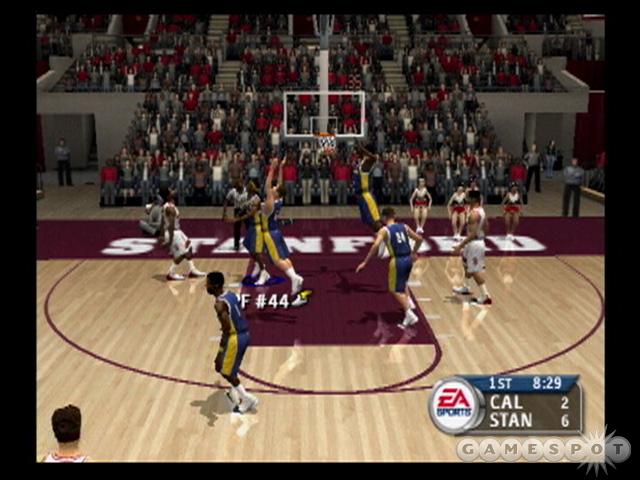With the release of NCAA March Madness 2004 on the Xbox and PlayStation 2, EA Sports has finished out its crop of sports titles for the year. The developers have carried a number of NBA Live 2004's great new features over to the college game, but they've been careful to differentiate March Madness from the pro game by using appropriate pacing and strategy. While March Madness 2004 does a good job at capturing the feel of college basketball, a general lack of polish keeps it just a little short of greatness.

March Madness 2004 does an outstanding job with sound. Many of the major team's fight songs are included in the game, and, as you compete, the crowd plays a major role. The array of chants you'll hear and the dynamic cheering and booing add a lot to the game's atmosphere. The experienced broadcast team of Brad Nessler and Dick Vitale handle the announcing in March Madness 2004, and they do an excellent job with varied and interesting commentary. However, it's worth noting that some people can't stand Vitale's effusive personality. If you're one of these people, March Madness won't do anything to change your mind about Dickie V.
Though the developers have done a great job at modeling most of the major college basketball venues, which include entertaining pregame and midgame cutscenes, March Madness 2004's graphics are somewhat of a letdown, especially for those who have played NBA Live 2004. The player models, in particular, suffer from an overall lack of detail. It's almost as if the artists spent more time on the mascots (who look pretty good) than on trying to make the players look a little less generic. The cheerleaders in the cutscenes also look rather primitive. These issues are somewhat less problematic in the Xbox version of the game, which sports much cleaner lines and edges than the PS2 version.
Animation also suffers a bit in March Madness 2004. General movement and dribbling juke moves appear to be missing a few frames of animation. This is a problem that is exacerbated on the PS2, which also has some minor frame rate issues. Perhaps more disturbing is the fact that the game suffers from a fairly noticeable ice skating problem--with players appearing to slide around the court instead of walking around it. On the plus side, the dunk and layup animations look pretty good, and the inclusion of 10-man motion capture does wonders for the overall look of the half-court sets. When the defense drops back in a zone, players have their hands held out to the sides and wait to deflect passes into the seams. Players on offense make cuts with their hands up for a pass, and they also fight through picks. Players jostling in the post have an especially wide array of animations, as the defender either fronts the offensive player or plays behind him.
The inclusion of 10-man motion capture also means that NBA Live 2004's slick trapping animations are included in March Madness 2004. The traps aren't quite as effective against the computer in this game, however, as the players are usually pretty smart about passing the ball out of danger.
Aside from the animations, the developers were thoughtful enough to include NBA Live 2004's other great innovations, including the separation of the dunk and shoot buttons and the pro hop button. Because you can force your player to attempt a dunk or layup no matter what the circumstances, you'll never deal with the maddening problem of having your man attempt a two-foot jump shot. The pro hop button also works the same way that it does in Live. If you're facing-up the basket and are dribbling toward it, your player will pick up the ball and execute a jump stop to try and free up for a dunk or midrange jump shot. If your back is to the basket while in the post, the button will execute a quick drop-step, which also terminates your dribble. As in NBA Live, the pro hop can push your opponent backward and reward you with a cheap dunk.
Overall, March Madness 2004 does a pretty good job at capturing the essence of the college game and keeps itself from feeling too much like NBA Live in different clothes. A lot of this has to do with the way the computer plays defense. In March Madness, you'll face a number of different looks over the course of the game, including a variety of soft zones, trapping zones, full-court presses, and standard man-to-man defenses. Assuming that you play against a team with a competent defense, you'll find that the computer is prolific at jumping into the passing lanes for steals and getting turnovers off of deflections. The AI is fairly intelligent at knowing when to employ various defenses, so, if you find yourself pulling ahead in the score, you'll suddenly face a full-court press. Fall behind and you'll see half-court zones that collapse into the post to prevent easy baskets. A momentum meter also appears in the corner, next to the scoreboard, but it seems to function somewhat strangely by awarding full momentum to one team or the other after just a couple of consecutive baskets.

You'll have an array of plays at your disposal by using March Madness' playbook, which includes a good variety of motion, triangle, stagger, and zone-busting sets. Unfortunately, it can be a bit of an adventure to get these plays to actually work. For some strange reason, when you call a play, your teammates don't always get into their proper alignments. If they do, they sometimes fail to make the appropriate cuts, or they'll run off of screens to try and get open. Fortunately, your players do a good job at moving around--even if you don't call a play. The basic plays, like screen-and-roll and post up, also work well, and you can adjust the standard set your players typically run against man or zone defenses from the coaching strategy menu.
March Madness carries some of the same flaws as NBA Live 2004. The midrange game doesn't seem to come into play very much, because defenders often react unrealistically fast when rotating out of their double teams--like they're almost psychic. Combine that with the high number of blocked shots you'll see at the default slider settings, and you'll find that most of the game is played above the rim or behind the arc. This is somewhat of a problem for a college basketball simulation because much of the real-life game centers on ball movement and finding ways to launch open, midrange jumpers in the seams of zone defenses. You'll also find that the computer players seem to use an assisted speed boost to catch your players from behind on fast breaks. Conversely, the computer gets an alarming number of outnumbered fast breaks in its favor, particularly at the highest difficulty settings. Additionally, the computer's ability to hit three-point shots, even with a hand right in the shooter's face, is also a bit suspicious, though, to be fair, you'll hit a surprising amount of your own deep balls in the face of pressure.
March Madness 2004 includes a fairly complete and extensive dynasty mode, which is similar in structure to the one found in NCAA Football 2004. You pick a team from the game's extensive list of more than 320 Division 1 schools (a few schools, like UC Riverside and UC Santa Barbara are represented by fictitious names) and guide it over the course of several seasons. You can create and customize a nonconference schedule to play, and you'll also play through both your regular conference slate and, if applicable, your conference tournament. If you're good enough, you'll get invited to the "Big Dance" at the end of the year to play in the NCAA Tournament for the national championship.
You're given a good number of options to adjust your team strategy, with sliders used to indicate tendencies, like inside or outside shooting attack, full-court or half-court defense, zone or man defense, and star player or team focus. Each week, a new Sporting News issue updates the All-America and all-conference candidates and changes the top 25 power ranking based on each team's play. The PS2 suffers from some unusually long load times while navigating these menus and also takes significantly longer than the Xbox to simulate the hundreds of games during the season. If you decide you want to simulate a few weeks' worth games on the PS2, you literally have enough time to get up, go to the kitchen, and fix yourself a snack while it sorts everything out.
After the tournament, you enter the off-season, where you compete with other schools to recruit high school players. Again, this portion of the game is structured similarly to NCAA Football 2004 but isn't quite as deep or well designed. Unlike NCAA Football, the location of your recruit doesn't seem to be a factor; it takes just as many action points to woo a player all the way across the country as it does to woo one in your home state. You can vary your recruiting pitch to the player based on such factors as prestige, location, and/or coaching philosophy. For some reason, though, you aren't given any specific feedback on the effectiveness of your pitch from week to week. This represents quite a departure from NCAA Football, which does give you feedback regarding your recruit-pitch effectiveness. It's puzzling that EA would choose to water down the great recruiting system that they used in their college football game.
Compared to its competitors, March Madness also falls a little short in its customizability and content. The create-a-school feature, for example, lets you pick out a logo, school colors, a name, and an arena type. However, your choices of logos and colors are extremely limited, and, for some strange reason, your school name and city cannot exceed 10 characters in length. Likewise, the create-a-player feature won't allow you to use more than 10 characters in either the player's first or last names either. This can be a problem if you're trying to fill in the roster gaps that March Madness seems to have included in some of the major teams. For example, Cal's default roster seems to be missing two of its four incoming freshmen. This is an oversight, as all four freshmen were nationally rated and are all expected to "play big minutes" for the team, which is rated highly within the actual game.

Aside from the dynasty mode, March Madness includes mascot games, rivalry matchups, tournament setups, and--on the PS2--online capability. As with all EA Sports games, the stats and wins you rack up in online play are available for viewing through the EA Sports Online Web site (leaderboards on the Web site don't appear to be working as of this writing, although they are visible within the game), and you can compete in tournaments, chat in lobbies, and add players to your friends list. Online play seems to be pretty smooth, although the volume of players doesn't seem to be quite as dense as it is for NBA Live 2004.
Overall, NCAA March Madness 2004 delivers a pretty good college basketball experience. It effectively incorporates the best features from NBA Live 2004, but it also maintains the feel of the amateur game with its presentation and strategy. Unfortunately, some rough graphics, a couple of gameplay flaws, and limitations in the recruiting mode keep it from being a truly great college basketball game.
